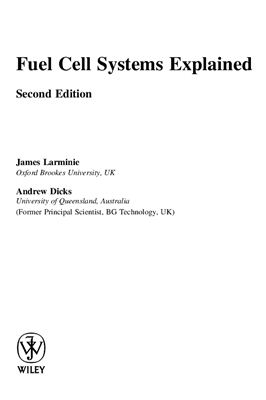John Wiley & Sons Ltd, 2003, p.433
A significant time generally elapses before any new technological development is fully
exploited. The fuel cell, first demonstrated by Sir William Grove in 1839, has taken longer
than most, despite the promise of clean and efficient power generation.
Following Bacon’s pioneering work in the 1950s, fuel cells were successfully developed
for the American manned space programme. This success, together with a policy to
commercialise space technology, led to substantial development programmes in America
and Japan in the 1970s and the 1980s, and more recently in Europe. Despite these efforts
that resulted in considerable technical progress, fuel cell systems were seen to be ‘always
five years away from commercial exploitation’.
This book offers those new to fuel cells a comprehensive, clear exposition and a
review to further their understanding; it also provides those familiar with the subject a
convenient reference. I hope it will also contribute to a wider knowledge about, and a
critical appreciation of, fuel cell systems, and thus to the widest possible application of
an exciting twenty-first century technology that could do much to move our use of energy
onto a more sustainable basis.
A significant time generally elapses before any new technological development is fully
exploited. The fuel cell, first demonstrated by Sir William Grove in 1839, has taken longer
than most, despite the promise of clean and efficient power generation.
Following Bacon’s pioneering work in the 1950s, fuel cells were successfully developed
for the American manned space programme. This success, together with a policy to
commercialise space technology, led to substantial development programmes in America
and Japan in the 1970s and the 1980s, and more recently in Europe. Despite these efforts
that resulted in considerable technical progress, fuel cell systems were seen to be ‘always
five years away from commercial exploitation’.
This book offers those new to fuel cells a comprehensive, clear exposition and a
review to further their understanding; it also provides those familiar with the subject a
convenient reference. I hope it will also contribute to a wider knowledge about, and a
critical appreciation of, fuel cell systems, and thus to the widest possible application of
an exciting twenty-first century technology that could do much to move our use of energy
onto a more sustainable basis.

